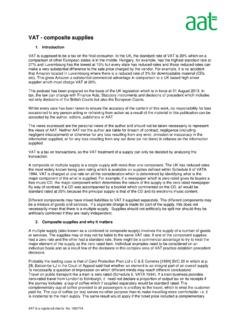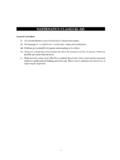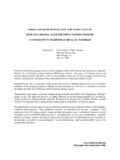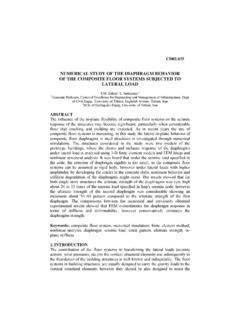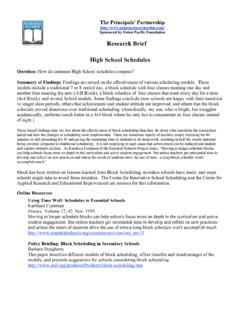Transcription of MOLDED FIBER GLASS COMPANIES
1 Technical Design Guide for FRP composite Products and PartsTechniques & Technologiesfor Cost E ectivenessMOLDED FIBER GLASS COMPANIESThis manual is an overview of the FIBER ReinforcedPlastic/ composite (FRP/ composite ) material and processes are presented along with designguidelines and comparisons to alternate materials. Becauseof the versatility of FRP/Composites, the designer isencouraged to collaborate with a molder and/or materialsupplier to optimize the are a combination of two or more materialsyielding properties superior to those of the individualingredients. One material is in the form of a particulate orfiber, called the reinforcement or discrete phase. The otheris a formable solid, called the matrix or continuous region where the reinforcement and matrix meet iscalled the interface. composite properties are determined bychemical and mechanical interaction of the combined and concrete are composites under this document is limited to the application of the subset ofcomposites called FIBER Reinforced Plastic (FRP) thatcombine fibers of GLASS or other materials (the reinforcement)with thermoset and/or thermoplastic resins (the matrix).
2 Definition of CompositesThe plastic resin systems determinechemical, electrical, and thermalproperties. Fibers provide strength,dimensional stability, and heatresistance. Additives provide colorand determine surface finish, andaffect many other properties suchas weathering and flame of FRP/Compositesinvolves complex chemical term fiberglass describes aFiberglass reinforced plastic,commonly known as fiberglass, was developed commerciallyafter World War II. Since that time, the use of fiberglass has grown plastic resin that isreinforced with GLASS this manual, the more generalterms FIBER Reinforced Plastic/Composites or FRP/Compositeswill be used to describe theseextremely useful material resins come in two differentclasses - thermosets andthermoplastics. From a practicalperspective, it s easy to rememberthat thermosets maintain their moldedshape at higher temperatures andcannot be melted and will melt at a giventemperature and can be solidifiedinto new shapes by cooling toambient temperatures.
3 Thermosetsand thermoplastics are describedwith more detail in the ResinSystems section of this fibers include GLASS , carbon,aramid and other man-made and naturalmateria ls that are further described inthe Reinforcement section of thisdocument. These are used in a varietyof forms and combinations to providethe required properties are determined bymany factors including the type,amount, and composition of theresin systems and addition, the use of additives cangreatly affect the areFRP/Composites?There can be many benefitsobtained by the use of FRP/Composites. These benefits andcharacteristics should be consideredearly in the design ResistanceFRP/Composites do not rust, corrodeor rot, and they resist attack frommost industrial and householdchemicals. This quality has been3responsible for applications incorrosive environments such asthose found in the chemical processingand water treatment to corrosion provideslong life and low maintenance inmarine applications from sailboatsand minesweepers to seawalls andoffshore oil Strength, LightweightFRP/Composites provide highstrength to weight ratios exceedingthose of aluminum or steel.
4 Highstrength, lightweight FRP/Compositesare a rational choice whenever weightsavings are desired, such as componentsfor the transportation StabilityFRP/Composites have highdimensional stability under varyingphysical, environmental, and thermalstresses. This is one of the most usefulproperties of Consolidation andTooling single FRP composite moldingoften replaces an assembly ofseveral metal parts and associatedfasteners, reducing assembly andhandling time, simplifying inventory,and reducing manufacturing single FRP/ composite tool canreplace several progressive toolsrequired in metal Dielectric Strength andLow Moisture AbsorptionThe excellent electrical insulatingproperties and low moistureabsorption of FRP/Compositesqualify them for use in primarysupport applications such as circuitbreaker housings, and where lowmoisture absorption is Finishing RequiredFRP/Composites can be pigmentedas part of the mixing operation orcoated as part of the moldingprocess, often eliminating the needfor painting.
5 This is particularlycost effective for large componentssuch as tub/shower units. Also, oncritical appearance components, aclass A surface is to Moderate Tooling CostsRegardless of the molding methodselected, tooling for FRP/Compositesusually represents a small part ofthe product cost. For eitherlarge-volume mass-production orlimited runs, tooling cost is normallysubstantially lower than that of themultiple forming tools required toproduce a similar finished partin FlexibilityNo other major material systemoffers the design flexibility ofFRP/Composites. Presentapplications vary widely. They rangefrom commercial fishing boat hullsand decks to truck fenders, fromparabolic TV antennas to transitseating, and from outdoor lamphousings to seed hoppers. Whatthe future holds depends on theimagination of today s designengineers as they develop evenmore innovative applications ResistanceHigh Strength, LightweightDimensional StabilityParts Consolidation andTooling MinimizationHigh Dielectric Strength andLow Moisture AbsorptionMinimum Finishing RequiredLow to Moderate Tooling CostsDesign FlexibilityMuch of the strength ofFRP/Composites is due tothe type, amount andarrangement of the fiberreinforcement.
6 While over90% of the reinforcements in useare GLASS fibers, other reinforcementshave established a critical is the most commonly usedfiber reinforcement. It is strong,has good heat resistance, and highelectrical properties. For morecritical needs, S- GLASS offers higherheat resistance and about one-thirdhigher tensile strength (at a highercost) than that of Fibers (graphite) areavailable in a wide range of propertiesand costs. These fibers combinelight weight with very high strengthand modulus of elasticity. Themodulus of elasticity is a measureof the stiffness or rigidity in amaterial. For high stiffnessapplications these reinforcementsare hard to beat, with a modulus ofelasticity that can equal steel. FRP/Composites with carbon fiberreinforcement also have excellentfatigue properties. The primary useof carbon fibers is in aircraft andaerospace, in which weight savingsare a major objective.
7 While its costlimits carbon s use in commercialapplications, it is used extensively wherematerial content is low, such assporting , or aromatic polyamidefibers (Kevlar or Twaron )provide high strength and lowdensity (40% lower than GLASS ) aswell as high modulus. These fiberscan be incorporated in manypolymers and are extensively usedin high impact applications, includingballistic Fibers such as Sisal, Hempand Flax have been used for manyapplications with low strengthrequirements. They are limited toapplications not requiring resistanceto moisture or high of the GLASS fibers -how the individual strands arepositioned determines bothdirection and level of strengthachieved in a MOLDED three basic arrangements of glassfiber reinforcement are unidirectional,bidirectional and arrangements providethe greatest strength in the directionof the fibers.
8 Unidirectional fibers canbe continuous or intermittent,depending on specific needsdetermined by part shape andprocess used. This arrangementpermits very high reinforcementloading for maximum fibers in a bidirectional arrangementare in two directions usually at 900to each other, thus providing thehighest strength in those same number of fibers neednot necessarily be used in bothdirections. High FIBER loading canbe obtained in woven or randomarrangements provide essentiallyequal strength in all directions of thefinished Fibers and Resinsadditives to prepare moldingcompounds for compression orinjection molding and otherprocesses. Various surface treatmentsare applied to ensure optimumcompatibility with different matrix or resin is the othermajor component of an FRP/ composite . Resin systems areselected for their chemical, electricaland thermal properties.
9 The twomajor classes of resins are thermosetsand ResinsThermosetting polymers are usuallyliquid or low melting point solidsthat can easily combine with fibersor fillers prior to curing. Thermosetsfeature cross-linked polymer chainsthat become solid during a chemicalreaction or cure with the applicationof a catalyst and heat. The highlevel of cross-linking providesfor reduced creep compared tothermoplastics. The thermosetreaction is essentially the thermoset resins forFRP/Composites, the family ofunsaturated polyesters is by far themost widely used. These resins aresuitable for practically every moldingprocess available for offer ease of handling,low cost, dimensional stability, anda balance of good mechanical,chemical, and electrical are supplied inseveral basic forms to provideflexibility in cost, strength,compatibility with the resin system,and process of the final form, allfiber reinforcements originate assingle filaments.
10 A large numberof filaments are formedsimultaneously and gathered into astrand. A surface treatment is thenapplied to facilitate subsequentprocessing, maintain FIBER integrity,and provide compatibility withspecific resin systems. After thistreatment, the strands are furtherprocessed into various forms ofreinforcements for use in Strand RovingThis basic form of reinforcement issupplied as untwisted strandswound into a cylindrical packagefor further processing. Continuousroving is typically chopped forspray-up, preform or sheet moldingcompounds. In the continuous form,it is used in pultrusion andfilament-winding RovingWoven from continuous roving,this is a heavy, drapable fabricavailable in various widths, thicknessesand weights. Woven roving costs lessthan conventional woven fabric andis used to provide high strength in largestructural components such as tanksand boat hulls.
